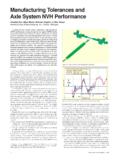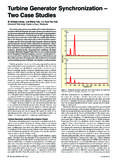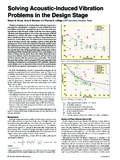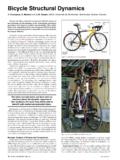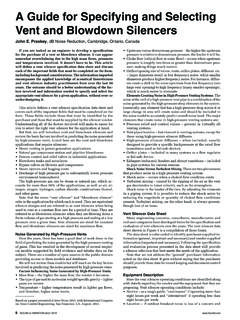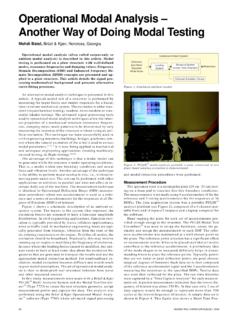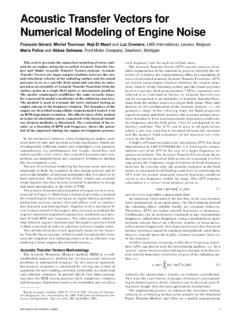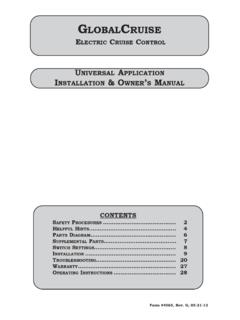Transcription of From Vibration Measurements to Condition Based …
1 SOUND AND Vibration /JANUARY 2007 Over the last seventy or so years, dramatic improvements have occurred in the technology, equipment and practice used for machinery Vibration measurement, Condition monitoring and analysis. From mechanical instruments that might capture a simple, low frequency Vibration waveform to today s high per-formance digital instrumentation, detailed fluid chemistry and oil debris analysis, motor current and circuit analysis, ultrason-ics and thermography, the change has been striking especially over the past twenty years. Adoption of the microprocessor field data collector/analyzer, the PC for automated monitoring, di-agnostics and information management combined with major improvements in electronics and signal processing technology have greatly advanced the ability to assess Condition , detect and diagnose anomalies.
2 It is almost beyond belief that today s por-table data collectors have greater functionality and performance than an entire truckload of laboratory analysis instrumentation less than twenty-five years ago! Today, the earliest stages of most flaws can be recognized in ample time to minimize the impact on production and avoid outright failure. Condition Monitoring and Condition Based Maintenance (CBM) have indeed come a long way! The path taken and how we arrived is an interesting story the individuals who contributed so much are owed an enormous debt of narrative of the progressive advancement of the technology and application of Vibration Measurements to industrial machin-ery can be defined by at least five major developments, Figure 1.
3 Each has accelerated the use, effectiveness and results gained from Vibration as a measure of mechanical Condition . From a simple overall amplitude measurement seventy years ago to the complex dynamic signatures utilized today for a detailed picture of Condition ; machinery Vibration monitoring and Condition as-sessment have become an essential element for the safe operation and effectiveness of today s modern process, production and manufacturing facilities. The First Great DevelopmentCondition Quantified Vibration Measurement and Severity Assessment Vibration as an indicator of Condition undoubtedly originated with the first rotating machine.
4 Although quantitative Measurements may have been far in the future, the first operators and mechanics must have felt cold fear in the presence of a badly shaking machine. High Vibration is not a comforting sensation that would lead anyone to a conclusion of well being personally or for the machine!Most attribute the beginning of the modern era of industrial Vibration measurement to Rathbone. Rathbone, then Chief Engineer, Turbine and Machinery Division, for the Fidelity and Casualty Company of New York, originated the first guidelines for judging machine Condition from Vibration Measurements in a paper published in 1939.
5 The paper, titled Vibration Tolerance and published in Power Plant Engineering, provided a guide for Condition assessment Based on Vibration displacement from ap-proximately 60 cpm (1 Hz) to 7,200 cpm (120 Hz).The Rathbone paper introduced a number of profound ideas including a set of amplitude versus frequency severity curves that approximated constant velocity around the rotating frequencies of typical steam turbine generators. The Rathbone severity criteria were Based on observations and represent the first known method for equating Vibration amplitude with Condition and by implica-tion, service life and risk of failure.
6 It is amazing to recognize that the concepts and severity criteria developed by T. C. Rathbone continue to serve us well today; sixty seven years later!Development of Electronic Vibration Measurement Much of the early Vibration measurement was accomplished with mechani-cal devices; the trusty, highly calibrated index finger, screwdrivers, a coin stood an edge were all used well into the age of electronic measurement. At some point the electro-mechanical, moving coil velocity pickup appeared (IRD introduced the Model 544 in 1952-53) to introduce quantifiable electronic measurement. The velocity pickup was reasonably robust and, most important, was self-generating with a low impedance output that was easy to handle with standard connectors and cabling.
7 With the electro-me-chanical velocity pickup, Vibration amplitude could be measured with a voltmeter. The Second Great DevelopmentIntroduction of Vibration (Frequency) Analysis As practitio-ners gained experience, there was a growing recognition that while amplitude was a good, intuitive measure of severity (the harder it shakes the worse it is!), frequency and frequency patterns indicated the type of defect present. Full exploitation of this theory was lim-From Vibration Measurements toCondition Based MaintenanceSeventy Years of Continuous ProgressJohn S. Mitchell, San Juan Capistrano, CaliforniaJohn S. Mitchell conducts Asset Management/Optimi-zation workshops, provides coaching, advice and support for organizations committed to improving the productivity, utilization and effectiveness of physical plant and equipment assets.
8 Positions held include: Site Manager in a large petrochemi-cal complex leading the imple-mentation of a comprehensive, site-wide asset productivity improvement and maintenance process transformation initia-tive; Vice President Mainte-nance Operations and Engineering with ABB, Inc; founder and president of MIMOSA, the Machinery Information Management Open Systems Alliance; Manager, Condition Monitoring Systems, Br el & Kj r, A/S; and President and CEO, Palomar Technology his more than 35 years of professional experience, Mitch-ell has been a strong, visible advocate for the development and implementation of business, technical, and operating strategies for optimizing the lifetime performance and utilization of indus-trial plant, equipment and infrastructure assets.
9 He has authored over 100 technical papers and articles and delivered numerous presentations and workshops throughout the world detailing the technological, financial, and business benefits of Asset Optimiza-tion, Profit-Centered Maintenance, Vibration analysis, Condition assessment and Condition Based maintenance. Mitchell is the author of two books: Physical Asset Management Handbook, Fourth Edition published in 2006 and An Introduction to Machin-ery Analysis and Monitoring. He is a graduate of the Naval Academy, Annapolis, 40th ANNIVERSARY ISSUE 63ited by Vibration analysis instrumentation that were very primitive by today s standards.
10 The earliest signal analyzer, the mechanical Hand Vibrograph shown in Figure 2, traced a time-domain vibra-tion displacement waveform on pressure sensitive waxed paper. A skilled user with an abundance of imagination could tell if the prime excitation was at rotating frequency, if other frequencies were present and little current era of Vibration analysis likely began in 1950 when Art Crawford, then a graduate student, today a universally respected giant in the industry, accepted a challenge to figure out a means to reliably balance high speed spindles. The ultimate result, IRD (International Research & Development), was incor-porated in 1952 and became the advocate and leader in dynamic balancing, frequency analysis and Condition assessment for over thirty years.
